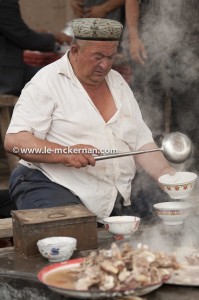Central Asia – Along the Silk Route 2010
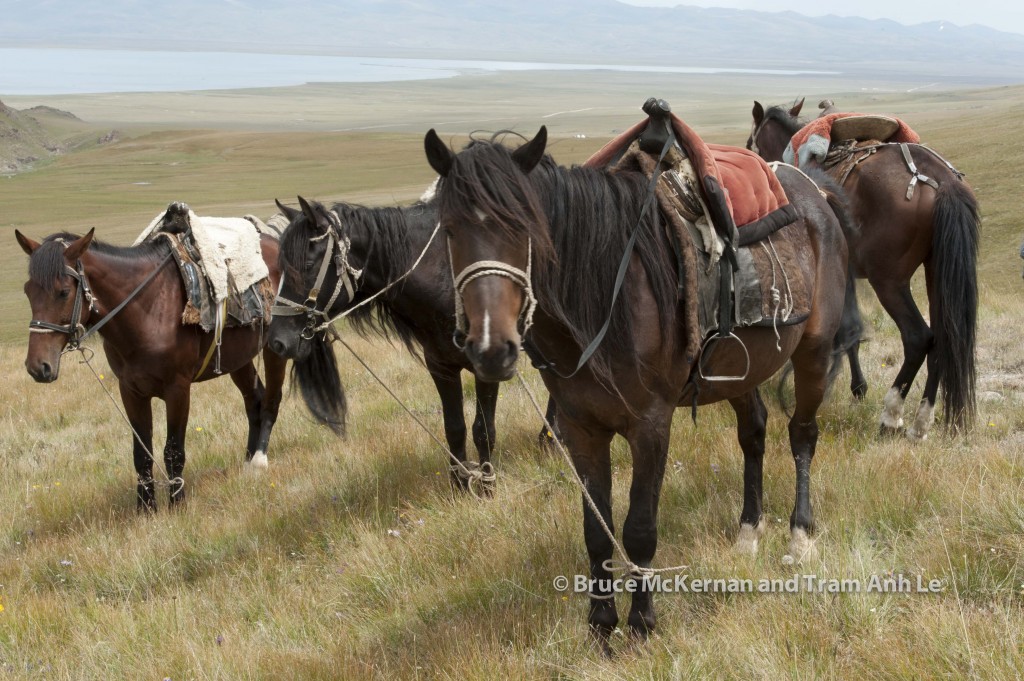
at Song Kul Lake, Kyrgyzstan
In 2009, we were inspired to travel along the Silk Route after reading an interesting article in the Financial Times about a group that travelled across the Pamirs in Tajikistan on horseback. Whilst we were fascinated with the idea of traversing the Silk Road on horseback, both Bruce and I knew that this would be particularly ambitious since neither Bruce nor I could competently ride a horse. So as a compromise, we selected an itinerary that had some riding (and in the interim, we taking riding lessons before the trip) but that the trip would be heavily weighted towards experiencing the cultural and historical aspect of the region. And from that one news article, the seed for our 2010 Silk Road odyssey was sown.

Map from the traveller’s pack – courtesy of Wild Frontiers UK. (However, please note that we would NOT recommend travelling with Wild Frontiers UK)
The above map shows the planned route. Unfortunately, due to political unrests and the humanitarian crisis in the Fergana Valley (and in particular, in Osh), our trip had to be amended to bypass this area. As such, the alteration resulted in days lost in avoiding the restive region and consequently, Dushanbe was dropped from the itinerary. But that was not the only complication — getting to the starting point was tricky as there were no direct flights from Hong Kong to Bishkek. Our actual route was: Hong Kong —> Seoul (overnight stopover) –> Tashkent, Uzbekistan (overnight stopover) –> Bishkek, Kyrgyzstan.
From there, our 21-days trip took us from Bishkek –> Song Kul Lake –> Tash Rabat –> Kashgar (along the Torugart Pass into China) –> Naryn, Kyrgyzstan –> Bishkek –> (flight to) Tashkent and then we drove thru the safe parts of the Fergana Valley (bypassing Osh) –> Kokand, Tajikistan –> Khodjent –> Panjikent –> Samarkand, Uzbekistan –> Bukhara –> Khiva –> Tashkent –> Seoul –> Hong Kong.
Our first stopover in Tashkent was an eye-opener to life in an ex-Soviet republic. We were warned beforehand that the Uzbek custom officials can be ‘particular’ and thus we had to declare every single bit of our electronics as well as account for all of our foreign currencies to the pennies on our entry form otherwise we risk trouble when departing. Fortunately, we had no problems when we made our connecting flight to Bishkek the next morning, but, we have heard of horror stories about customs officials challenging people for the silliest things — in one case, a couple had their their wedding rings challenged because these were not declared when entering the country!
Changing money was also another interesting experience. At the hotel, there were signs everywhere reminding tourists that it was illegal to change money anywhere except from a Uzbek bank. But, the moment the baggage boy helped us with our luggage into our room, he offered to exchange money and his rate was better than the bank’s rate. Mindful of the warnings, we’d politely declined. It was quite fortunate that we did decline because we later discovered that at the current rate, US$100 yielded two brick-sized wad of local currency. Impossible to fit discretely in a wallet or in our travel pouches, the local currency was transported around in big Ziploc bags. But, after a day of sightseeing plus dinner and drinks, we only had a few Uzbek sum left. To our surprise, we found it impossible to use the last of our Uzbek sums at the Tashkent Airport! The hunger for foreign currency was such that the Uzbekistan International Airport refused to accept it’s own local currency and thus if we wanted to purchase water, etc. then we had to pay for it in either US dollars or euros.
The other interesting observation about changing money in Central Asia (not just in Uzbekistan) was that the money changer will only accept crisp, clean foreign bills. Any rips, marks or excessive folds in the currency resulted in the money changer refusing to accept it. And, whilst there was only one official published exchange rate, in practice, there were many official rates based on the size of the denomination exchanged — the lower the denomination, the poorer the exchange rate and conversely, the higher the denomination, the better the exchange rate. In other words, 5 twenty dollar bills have a relatively poorer rate than 2 fifty dollar notes. As such and contrary to conventional wisdom, for travel to Central Asia, it was preferable to travel with the largest possible denomination of foreign currency.

Bishkek – Central Square
We had a day to ourselves in Bishkek before meeting up with our travel group. Coming from Hong Kong where the weather is typically hot, humid and sky overcast (due mostly to the terrible air pollution), we were overjoyed to be bathed in blue skies and crisp, clean and cool weather. The task we’d set for ourselves that day was to explore the city by foot and to find Lenin’s statue. After the fall of the Soviet regime, Lenin was moved from the his prime real estate and relegated to a less prominent position somewhere in the city. Armed with a map and good walking shoes, we’d started our exploration. After a few hours and a few misdirections, we finally found him — he’s now in the same square as the American University!

The next day, we meet our travel group and before setting off to rural Kyrgyzstan in a zill (an indestructible Soviet truck converted into a people carrier), we needed to pick up some essential supplies. First stop was the Osh Market. And, the Lonely Planet was completely accurate about the corrupt plain-clothed policemen on patrol at Osh Market. No sooner had Bruce taken 30 steps into Osh Market, someone grabbed his sleeve and demanded to see his passport. This was the beginning of a shakedown. Fortunately for us, our local travel guide was nearby and came to our rescue. The first step was to politely but firmly refuse to hand over Bruce’s passport and then politely and firmly refuse to ‘follow him’. The plain-clothed policeman wasn’t going to easily give up on his shakedown. So, the next step was for our guide to go on the offensive — our local guide then demanded to speak to the policeman’s superior officer. By this time, a small crowd started to gather around us. Using the power of the public attention, the local guide then shamed the policeman by asking him why he was targeting tourists especially given that tourists were presently very scarce at the moment (due to a recent violent uprising) and as a result he was hurting national interests. At this point, the police relented and Bruce was ‘released’. Needless to say, we hoofed out of Osh Market ASAP.
Before setting off on our road trip along the Silk Route, we needed a cultural hit and thus visited the National Museum. The Soviet propaganda from a bygone period was the highlight of the museum’s treasure. In particular, in the photograph below, it’s is said that the cowboy riding the missile is an avatar of Ronald Reagan!
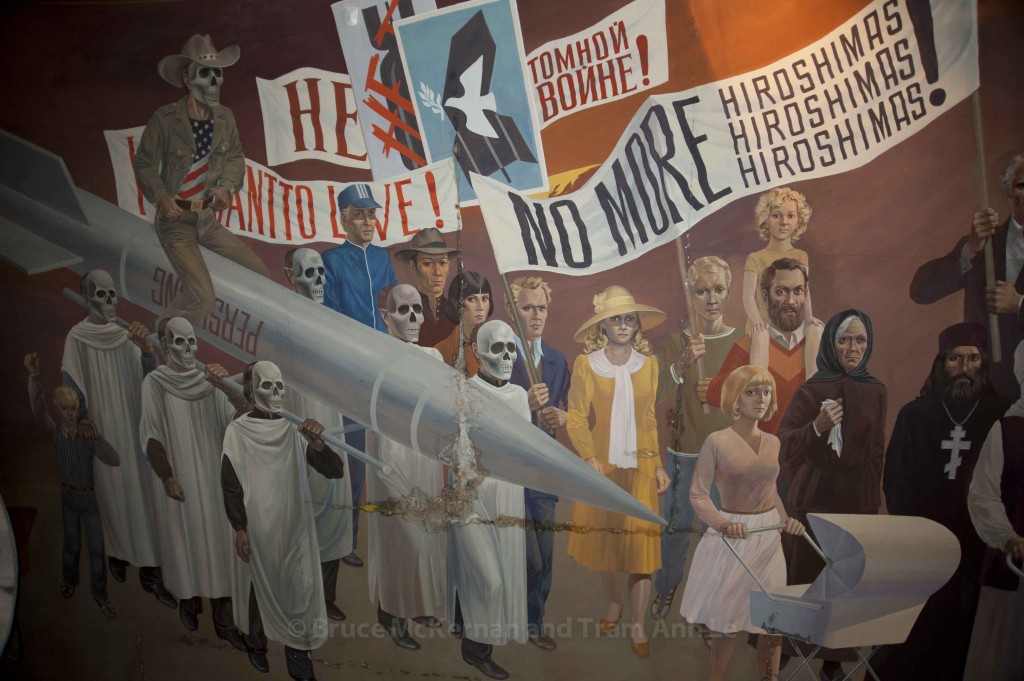
The Kyrgyzstan countryside was as varied as it was beautiful. At times, the field of sunflowers evoked Provence, France. At other times, the Tian Shan mountain range brought back memories of Switzerland. But the occassional farmer’s market alongside the road was pure Central Asia — and the melons from this region were some of the finest (juicest and sweetest) melons we’ve ever tasted!
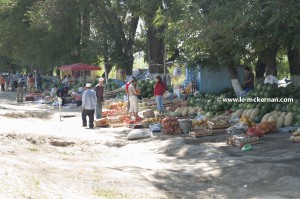
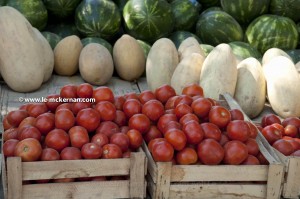
Traveling in a zill was an unforgettable experience. It’s difficult to express in words what it is like to ride in one of these (other than you need to have a strong constitution and no history of back pain). In lieu of words, there is a short video clip — please click on the below image to access the video. Whilst a zill was a characterful form of transportation, it was unfortunately slower relative to 4x4s and thus we spent hours (and hours and hours) in it. The advantage with the zill was that we could go off-road (if necessary), but, the trade-off was that we spent more time in transit than really necessary.
After a full day in the zill, we finally arrived at our destination at Song Kul Lake in central Kyrgyzstan. For several days, we stayed with a local family in one of their yurts. Nights in the central open plain were amazing — there was absolutely no light pollution and thus we saw the clearest and most remarkable starscape. And although it was August, a wood-burning stove was lit in each yurt for warmth. The smell of wood-fire always take me back to memories of Christmas in Yorkshire. And, so it was that on a cold summer’s night in Central Asia, I laid in bed thinking of mulled spiced wine, minced pies and other delights associated with XMAS. Surreal.
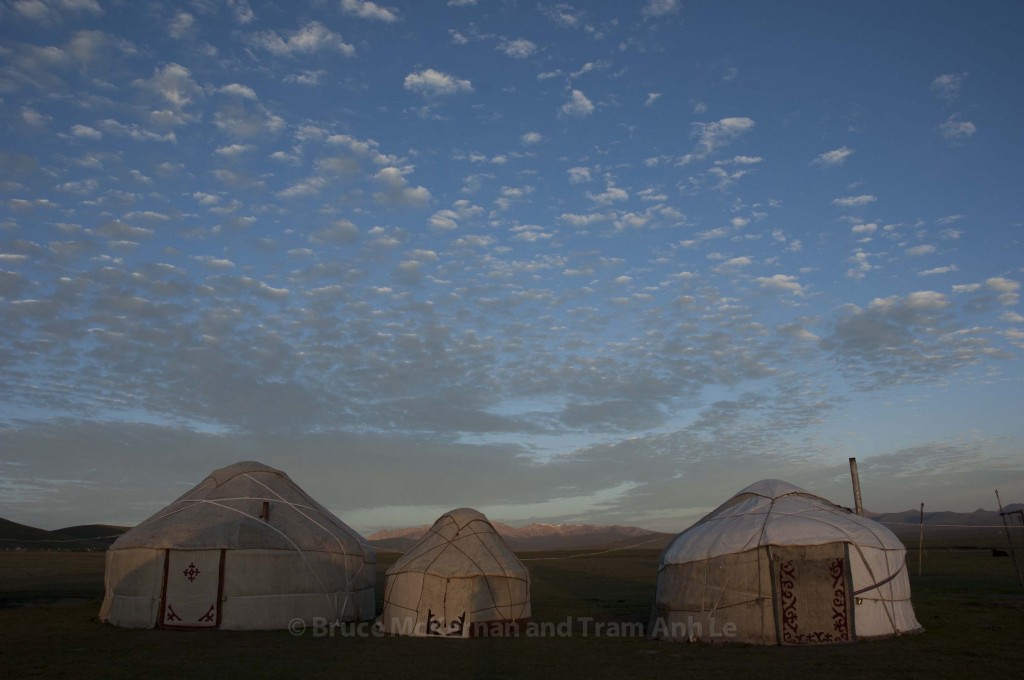
The sunrise that morning was glorious — the lake blazed in golden light. As we chowed down breakfast (local yoghurt, bread, jam and coffee), the family prepared their horses for us. This day was the culimation of one year of horse riding lessons almost every Saturday whilst in Hong Kong (at www.ceec.hk). As complete novice riders, we knew that it would be foolish to try to ride a horse for the first time in Central Asia so we started taking lessons one year out. And, that decision paid dividends. Although the horses were placid and agreeable, the terrain and the remoteness of the location meant that we had to be confident and competent riders.
Once we returned from our day out exploring the area on horseback, the family that hosted us invited the locals over to demonstrate and showcase their national games including: horse wrestling, picking up parcels from the ground whilst in trot, wrestling, and ‘kidnap the bride’.
Krygyz horse wrestling does not simply involve pulling your opponent off his horse. (That would be too simple.) The wrestlers use their horse’s heads to literally head-butt their opponent whilst at the same time the men would punch, whip, and pull at each other until the opponent is off his horse!
To win at the parcel game, the rider must have amazing dexterity as he rides his horse whilst concurrently hanging off his horse in order to pick up a small parcel from the ground.
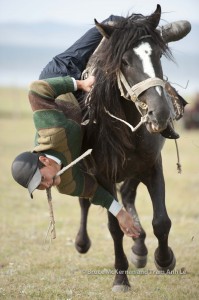
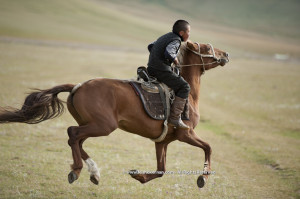
And, in ‘kidnap the bride’, the female has a head start. And if she manages to out-race her pursuer, then in round 2, she gets to whip her pursuer (assuming of course that she can catch him)! Although there was a fair amount of merriment in watching this game, ‘kidnapped bride’ is not something to be taken lightly as it is a present day threat for many women as it is still very prevalent in Central Asia. In fact, our hostess herself was once a kidnapped bride. Telling her story, she admitted that at first she was deeply unhappy as she was taken away against her will and not permitted to see her family until much, much later. But, after a few years, she came to the realization that she “married a good man” and thus she began to love him. Interestingly, when we asked the host (i.e. ‘the kidnapper’) what he would do if HIS daughter became a kidnapped bride, he admitted that he would not like it at all and that he would do his utmost to stop it from happening. It’s difficult for us to be objective here as this is not part of our culture. But, looking at the family, they seem to be happy and content (they have two lovely children — a girl and boy).
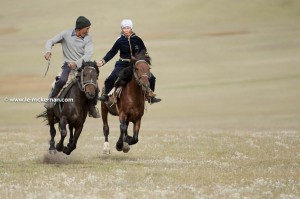
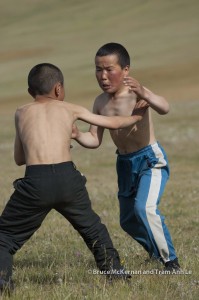
After the horse games, the local boys demonstrated to us their skill and dexterity in wrestling. And, to conclude the festivities that evening …. VODKA! During the vodka celebration, I noticed that whilst the local men accepted the women in our group as ‘Western Women’ and therefore different, the men were still vry traditional and not comfortable shaking the women’s hands when leaving. Instead, the women got a polite nod for ‘goodbye’ from the local men. But, the Western Women got double kisses on the cheeks from the local women (which the Western Men didn’t get !!!) so, in the end,I think that the Western Women got the better deal!
After a few days at Song Kul Lake, it was time to hop back onto the zill for Tash Rabat — famed for it’s caravanserai which is half-embedded into a hillside. According to the Lonely Planet, “local sources say it dates from the 15th century, although some sources say the site dates from the 10th century when it was a Christian monastery. Either way, historians agree that at one time Tash Rabat must have had significant Silk Road political and trade importance to justify the investment of the labour required for its construction”.
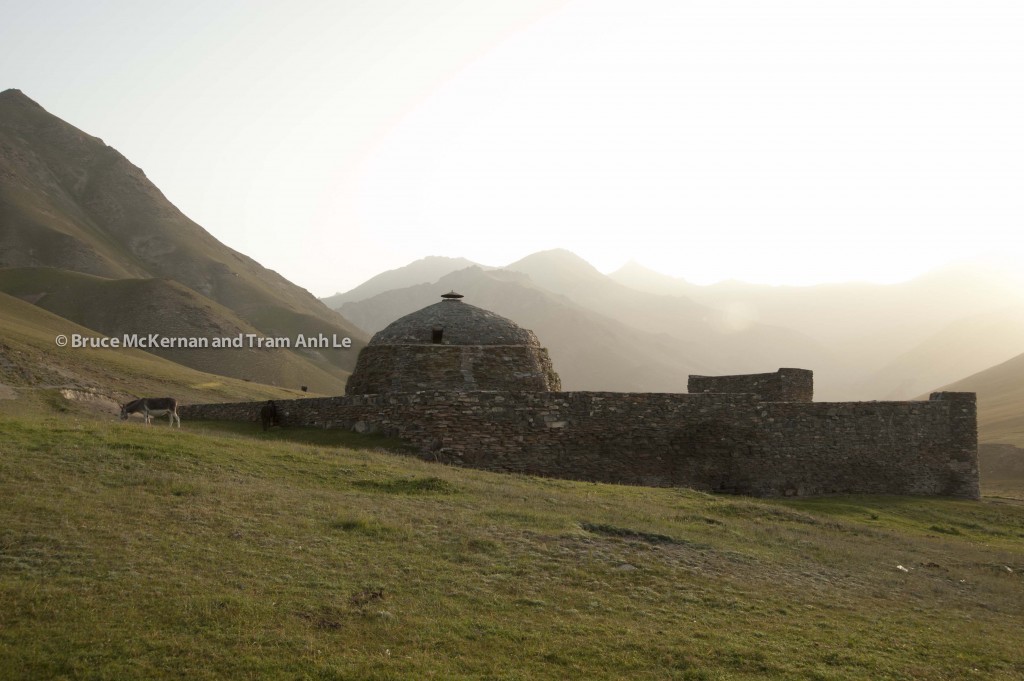
Tash Rabat Caravanserai

Tash Rabat Caravanserai

We stayed with the local ground keeper and his lovely family. The family had a small house and thus our meals were taken indoor (instead of from a dining yurt). As they had a working kitchen, the food was more varied and I vividly remembered a particularly delicious garlic eggplant mash with warm flat bread.
In addition to earning an income looking after the caravanserai and for hosting tourists, the family also produced wool and felt. During the winter when there are no tourists, the family produced wool slippers, wool mats, felt wall hangings, etc to sell to the summer tourists.
Sadly, our 2 nights at Tash Rabat was our last time in a yurt. From this point onwards, we would be in either hotels or homestays. A yurtstay is not for everyone as the amenities are very basis. But, we loved it. If the yurt is carpeted, then it is customary to leave your shoes outside, or, inside but by the wood-stove. Our sleeping arrangements were communal with the women in one yurt and the men in another. Each yurt is purpose-specific so there is one for sleeping and a separate one for eating.
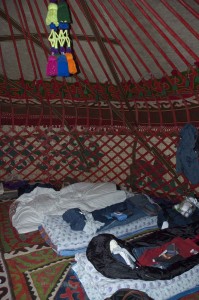

Saying goodbye to Tash Rabat and the yurts, we’d hopped into the zill to reach the Kyrgyz-China border. We spent most of that morning traversing the Torugart Pass before reaching the border. Given Torugart’s reputation as one of Asia’s most unpredicatable border crossing, we were pleasantly surprised at getting thru border control without any hassle. But the border crossing meant that we had to exchange the zill for a mini-bus at the Chinese border as the zill could not cross.
It is often said that Kashgar is a tale of 2 people — the local Uyghur and the Han Chinese. This saying is deeply rooted in truth as there were many times that I had to remind myself that I was actually in China.

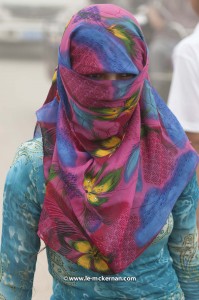
yes … this _IS_ from China
Although this is a politically sensitive region, we had no problems walking the streets and markets. And, once, when we walked thru Old Kashgar we were invited by a family to tea in their courtyard. Although we were complete strangers, the code of hospitality was particularly strong and we were completely welcomed by this lovely family. But the best memories of Kashgar was from the evening we ditched our group and elected to roam the streets of Old Kashgar under our own steam. What was particularly memorable was when Bruce and I purchased some hot buns from a food cart and as we were walking down the street munching away on our food, a man on a Vespa-like motorcycle came from behind us beeping his horns. When he got our attention, he said something to us that we could not understand and then handed to us a bag full of these buns. He then gave us a nod and then drove back in the direction he came. We were completely baffled but could only surmised that the food seller must have over-charged us originally. Either out of guilt, or, shamed by his friends, the food seller then sent his mate to find us and give us this bag full of hot buns.
Videos from Kashgar:
Sadly, the glimpses of Old Kashgar that we saw will soon be relegated to history as the local authorities are pursuing a wholescale forced refurbishment of the area. In place of the traditional low-rise houses with a courtyard as the heart of each home, the Uyghurs will be rehoused to modern apartment blocks. The government says that this is for the good of the Uyghurs, but, the Uyghurs disagreed. Our local guide advised us that the apartments are viewed as nothing more than cell blocks. The security cameras (to protect them) could be used to monitor the locals. And more importantly, without a courtyard for their animals, these new apartment blocks are the death knell to the Uyghur’s traditional lifestyle.
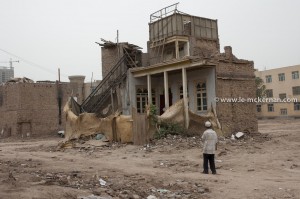

We were exceptionally fortunate to be in Kashgar on a Sunday as this enabled us to visit the famed Sunday Market. Enroute to the market, we saw all sorts of vehicles transporting livestocks on the highway. Although never cruel, the treatment of the animals at the market can be discomforting to those who are accustomed to Western animal welfare practices.
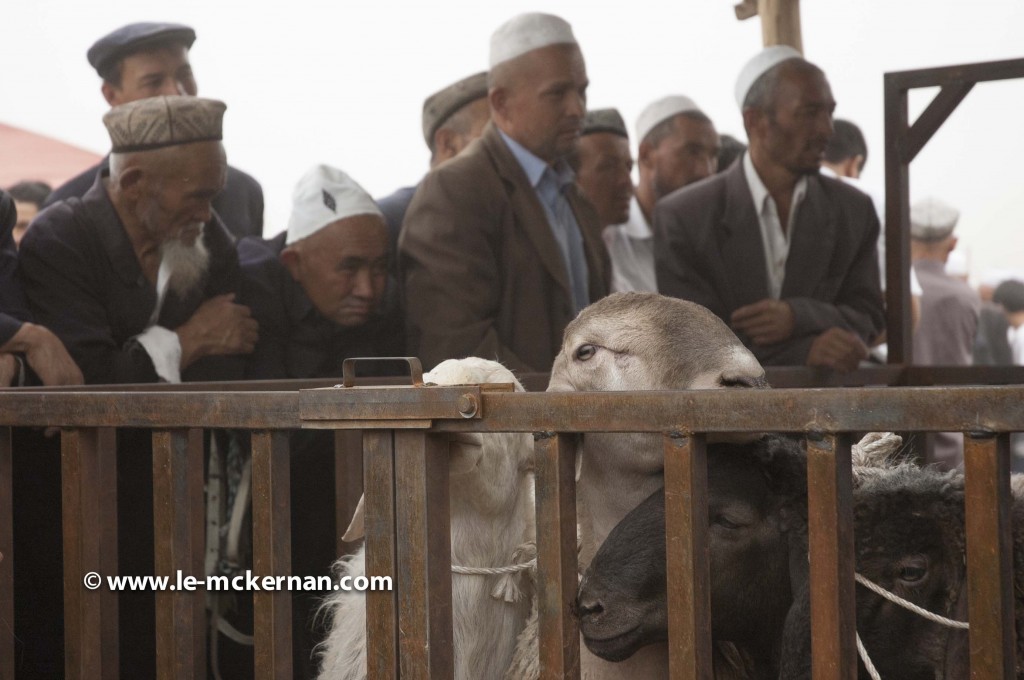
After Kashgar, we had to recross the Torugart Pass enroute to Bishkek (via Naryn). Succinctly, we had an ‘interesting’ border crossing. (I’ll save the details of this border crossing for another blog at another time.) The next 2 days was a blur as we were in the zill racing to get to Bishkek for our flight to Tashkent. The original plan to visit Osh and the surrounding area was scuppered as the area was deemed unsafe for foreign visitors. And, that was a major disappointment for us because we wanted to experience as much of Kyrgyzstan as possible — but not from the window of a zill.
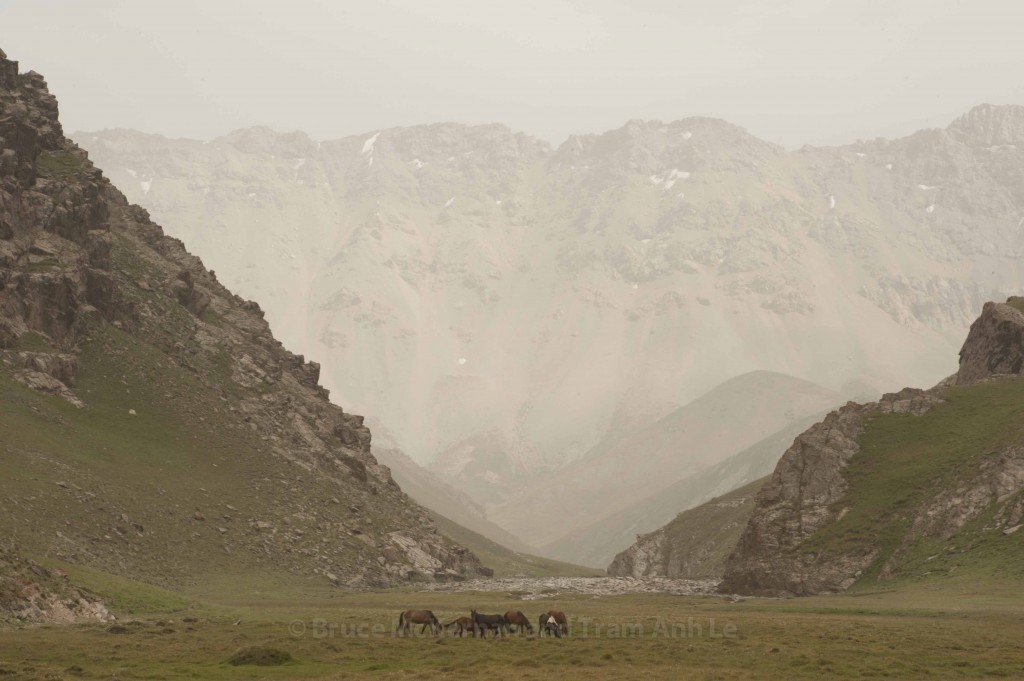

Once we landed into Uzbekistan, everything was also a blur as the ground crew bundled us into a caravan of cars and drove like maniacs to get us to our next destination in Tajikistan. Although we’ve been in ‘fast and furious’ car situations before — i.e., in India (but there is an element of “organized chaos” on Indian roads) and in Turkey (crazy, crazy taxi drivers!!!) — the situation in Uzbekistan was one of just pure manic driving. Fortunately, our car had functioning seat belts. (Unlike the time when we were in Cambodia — our taxi driver noticed our discomfort when we’d realized that the seat belts were not working and he said — and this is a direct quote — “don’t worry … if we crash, we will crash slowly” !!!) At the first pit stop, we had a quiet word with our tour leader and she then had a word with the drivers. From then onwards, the drivers drove a bit more responsibly.
The border crossing from Uzbekistan to Tajikistan was staff with young men (boys?) with guns. Fortunately, these boys were sweet — they even tried to flirt with some of the ladies in our group. But, I think we had the last laugh — one of the ladies in our group is an ex-SAS soldier and therefore knew an unloaded gun when she saw one — but we didn’t let the boys know that we knew. First, that would have pricked at their pride, and second, it would not have helped us cross the border any faster.
Once we passed border control, we were bundled into another set of cars and trundled off. The Fan Mountain has some amazing landscape — noticeably, some of the passes on this mountain range are particularly treacherous as we saw many skeletons (trucks and cars) littering the side of the mountains. Nonetheless, our drivers zipped thru this that area rather quickly(!). We also observed that there were A LOT of Chinese construction workers toiling on the main Tajikistan highway (and many Chinese trucks carrying goods into the heartland). It is clear that China is building a modern ‘silk road’ thru Central Asia and nowhere was more obvious than on the main road thru the Fan Mountains.
After many hours in the car, we’d arrived at our first homestay. A characterful homestay would have been the perfect antidote …. but, this was not to be. Although these homestays were 10x more comfortable than our yurtstay, I can honestly say that I prefer the yurts because it had more charm and more importantly, we had more interaction with the local family. Our homestays in Takijistan (and Uzbekistan) can only be described by the following routine: arrive in the evening, tidy up, eat, drink and then sleep. It was in essence nothing more than a hostel. We had very limited interaction with the local family and that was a huge disappointment because the idea behind a homestay is to get-under-the-skin of a place. To make matters worse, neither the tour operator nor the ground crew did their homework as some of the places that we stayed were wholly inappropriate. As it was too late to ameliorate the the homestay arrangements, Bruce and I just had to grin and bear it.
After a few days in Tajikistan, we headed back over to Uzbekistan again to hit the “must see” on any Silk Road itinerary — Samarkand, Bukhara and Khiva. These three grande dames didn’t disappoint. But, sadly, Samarkand was quickly becoming a bit too Disney-fied. The old and characterful streets have been bulldozed over and these were now wide, tree-lined boulevards. Furthermore, everything was too clean and too modern.
But, if you scratch the surface, the old blood still pulses. And so, we scratched. We heard that it might be possible to climb in one of the towers in Samarkand if you tip the guard on duty for access. And the guard gladly gave us access — and left us alone to explore the tower. The problem is that this place was DANGEROUS (note: no health & safety regulation in practice). The internal tower was very dark (fortunately, we were well prepared with head torches), there were huge gapping holes/pits, and the stairs did not have any safety railing. And once we were under the tower itself, only 1 person can realistically climb the tower because the steps were very steep and the passage was very narrow. At the top, the openning was tiny and the view was restricted. How the guard must have bellowed with laughter knowing that we put so much effort to see so little! But, the upside was that because it was very early in the morning, we were the only tourists and thus had the full place to ourselves to roam around at will!
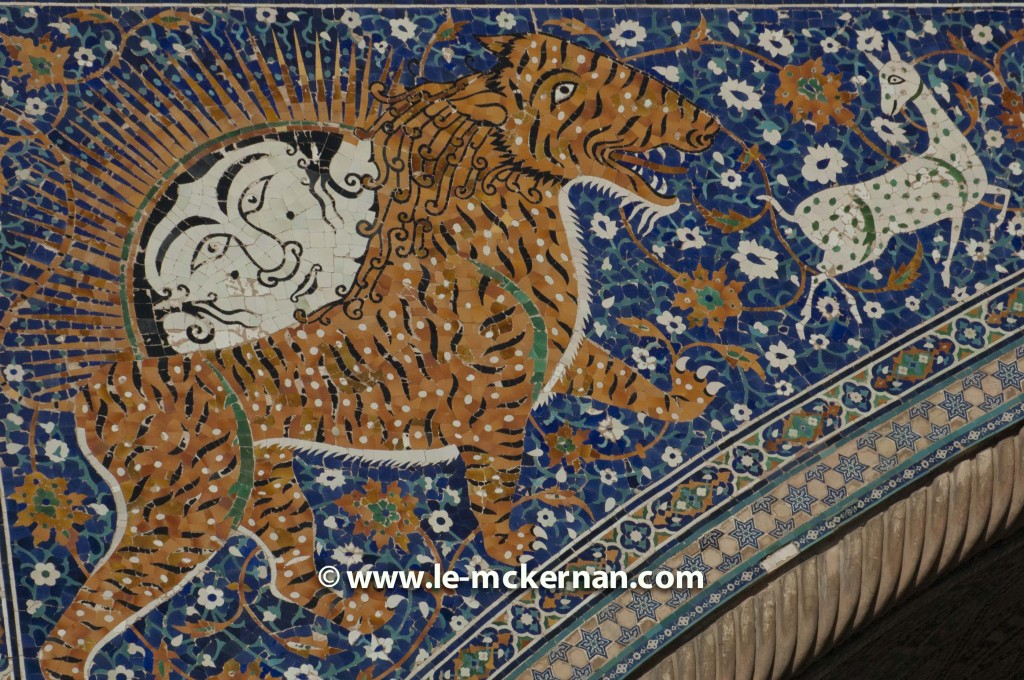
In Bukhara, we visited several craft shops. Despite my herculean attempt to resist, I’d cracked (no surprises here) and purchased a few embroidered cushion covers and a gorgeous large duvet cover. These are definitely not machine-embroidered — because after the purchase, I found a small bit of dried apricot stuck onto the duvet cover! I love the idea that someone was snacking whilst stitching my duvet cover. It just made me love this piece even more!
In Khiva, we’d stayed in a hotel that was once a madrassa (religious school) with a courtyard at the center of the complex. Khiva is an UNESCO protected old town and as such it avoided the Disney-ification of Samarkand. Like a grade-listed building in the UK, there are restrictions around what could be done to the old forted city — but, it does not stop modernity. Thus and although we were in an ancient and protected city, it didn’t feel quite authentic. Perhaps the huge amount of tourist tat (presumably for our benefit sadly) overwhelmed the quiet charm of the city. Happily, the quiet charm was still strong outside the tourist area. We walked along the fort walls of Khiva and we were enchanted by the residential neighborhood. Inspired by the site, we decided that we would return to the fort wall again at sunrise the next morning to try to capture the magic of the residential area. Sadly, as this was at the end of our 21+ day trek and as we were tired, this sunrise walk unfortunately did not materialized — we were too comfortable in bed that morning.
My favorite memory of Khiva was when we’d encountered a woman in the street carrying a beautiful handmade and hand-painted cradle. We spoke to her and discovered that the cradle was for her 3-day old grandson. She was beaming with joy and pride. So much so that she allowed us to photograph her smiling — this is very unusal in Uzbekistan. This is because most people have gold teeth and when it comes to being photographed, they will almost always smile with a closed mouth. This was my last portrait shot on the trip and it was the shot I wanted — a beautiful smile to go along with a beautiful memory of a happy grandmother!
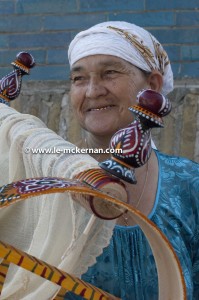
Uzbek grandmother
In summary, this trip was a great first-taste to Central Asia. Despite the strenuous border crossings, bureaucracy, and shakedown at Osh Market, the overwhelming kindness and hospitality of the people in Central Asia trumped all the negative aspects of this trip. As such, Bruce and I are still very excited about coming back …. and perhaps, this time we would do the Pamirs on horseback!
Photo Albums:
+ + + +
We’d traveled with Wild Frontiers UK (www.wildfrontiers.co.uk) on their ‘Silk Road Odyssey’ package. Based on our experience with this company, we would N O T recommend Wild Frontiers UK to our friends and family. To understand why, please see my OP-ED.
But, we would recommend the Kyrgzy local guide “Tommy” (full name: Artem Volkov) who can be reached at fenrir83@mail.ru or at +996 555 99 33 15. He was awesome!
OP-ED: Travelling with Wild Frontiers (UK) – a terrible experience!

The feedback on this page pertains to Wild Frontiers Adventure Travel Ltd, www.wildfrontiers.co.uk and wildfrontierstravel.com only (and not to www.wildfrontiers.com which is a separate travel company specialising in safaris).
Please note that this is not an “I hate Wild Frontiers” rant. Rather, the purpose of this blog is to help people make an informed decision about whether or not they should travel with WF UK (** see notice below). This blog provides a summary of my experience with WF UK and I hope that it provides an alternative opinion to help counterbalance the gushy testimonials on WF UK’s site and marketing materials.
First, the basics: my husband and I travelled to Central Asia in August 2010 with Wild Frontiers UK as part of their “Silk Road Odyssey” tour covering Kyrgyzstan, Kashgar (China), Tajikistan and Uzbekistan. Although there were many other travel companies offering similar itineraries and were significantly cheaper, we elected to travel with WF based on: WF’s expert knowledge of the region; deep local contacts; ability to deliver “a truly authentic, off-the-beaten-track experience”; their “no hidden costs” promise; and the positive client testimonials. Given that this trip involves multiple border crossings (and hence, the logistics would be exceptionally daunting), the remoteness of some of destinations, and the rich history of the places we would be visiting, we thought that their expertise justified the premium. We were wrong.
Based on my 2010 Silk Road Odyssey experience and in my opinion, most travellers would do just as well armed with a copy of the Lonely Planet. Not only would this save travellers serious money but I daresay that they would have a more authentic and more satisfying experience. Whilst my husband and I actually did enjoy our trip to Central Asia, we both felt that this was because the region itself was amazing. In other words, the overwhelming beauty and history of these countries enabled us to compartmentalised the faults, failures and the overall amateur execution of the trip and to not allow these issues to derail our trip.
In the marketing dossiers, there is a page titled “Why Wild Frontiers?”. Allow me to share with you my experience and opinion on “Why NOT Wild Frontiers?”.
1. Not at all authentic
In their marketing materials, it stated “our unique, original itineraries allow our clients to take journeys that venture beneath the surface of the region …. we don’t subcontract our trips … we are able to give a truly authentic, off-the-beaten-track experience.” Furthermore, at the orientation meeting with our tour leader, she’d talked about WF’s ethos as a “travel company for travellers”. She then proclaimed that on this trip, we would be “travellers and not tourists”. But, to be honest, I never felt more like a tourist than I did on this trip! Travellers we were not!
Excluding the time we’d spent at Song Kul Lake and Tash Rabat, the itinerary was neither unique nor original. Based on what I’d observed, the WF tour leader didn’t set the day-to-day plans — the local subcontracted guides did. As such, we basically followed the subcontractor’s itinerary which in essence is the bog-standard itinerary for all tourists. Thus, we kept running into the same tourists from other groups over and over again — at the restaurants, at the sites, and just about everywhere else! The subcontracted guides did more than just set the plans — at times, they were ‘in the lead’ and not our WF tour leader. A particular galling example was in Uzbekistan when our WF leader decided that she wanted a break (to catch up on her travel blogs) and thus abdicated all her responsibilities for the day to the local guide! ( Question: what is the point of hiring WF to provide expert tour leads if they themselves can’t be bothered to lead? )
Upon return from this trip, in my feedback to WF, I’d questioned the use of and the prominent role played by the subcontractors because WF’s marketing materials clearly stated that ‘WF does not subcontract’ out their trips —
WF’s response to my feedback is below. (My feedback is in black font whereas WF’s response is in blue.) I’ll let you decide if the two statements are compatible.
Moving away from the issue of subcontracting, the overall experience was not what I would describe as authentic or off-the-beaten-track. For example, for our first night together with WF in Kyrgyzstan, dinner was at a pasta/pizza restaurant. This was not a fluke because later as we transit thru Bishkek again, dinner that night was at a different pizza restaurant. To be completely frank, I didn’t travel thousand of miles to Central Asia to eat Italian!
2. “NO Hidden Extras” does NOT mean “no hidden extras” 
There were definitely hidden extras on our trip. First, we had ‘the option’ of having a traditional dance troupe perform for the group at dinner — but this was during a dinner that was part of the tour and thus it would not be possible for people to ‘opt-out’. As a result, everyone had to contribute to the cost …. and it was expensive!
Second, although the “What’s Not Included” in the marketing dossier does include tipping for local guides, it does not mention anything about tipping for ‘the extras’. This extra cost is later mentioned in the pre-departure pack, but, you would only get this information AFTER you have made a deposit to secure your position.
If the ‘no hidden extras’ policy is an influential factor in the decision to select WF (as in my case), then getting the exclusion list afterwords is moot. Once I saw the details in the pre-departure pack, I felt deceived but by then it was too late to back out as the flights were already booked.
Furthermore, during our trip, we were asked to ‘top up’ the tip kitty several times and to make matters worse, there was absolutely no transparency in how the tip kitty was allocated. When I’d asked, I was told by the tour leader that the extra money would be distributed to the drivers, bell boys, restaurants, etc. etc. If WF is truly serious about their ‘no hidden extras’ promise, then these expected costs should be “fully baked into” the overall tour cost, or, there should be full disclosure at the outset (i.e. in the marketing dossier and not in the pre-departure pack).
Without this disclosure, tips to these extras are, in reality, a hidden (and rather significant) expense.
3. Inappropriate Accommodations / Lack of Preparedness
I am a big fan of homestays as this is a great way to really to get to know the people and their culture. Whilst I applaud WF for championing homestays in Central Asia, the overall homestay experience (specifically relating to that in Tajikistan and Uzbekistan) was disappointing. In particular, some of the accommodations selected by WF (or, rather, by the ground handlers appointed by WF) were wholly inappropriate for a group of our size.
At one place, there was only one available loo and the family did not want us to use their garden as an alternative. Fortunately, at that time, no one had traveller’s diarrhea, but, if someone was ill then one loo would have been a complete disaster. (This was 1 toilet for 13 tourists, 1 WF guide, 1 local guide, 5 drivers, and the local ground support!)
At another place, our ground handlers had no-clue about how many rooms and how many beds would be available to us at the next homestay that evening. In other words, no one (neither the local agents nor WF) did their homework beforehand! And thus, at one point in the day, we were warned that we may have to all snuggle together three-in-a-bed (!!!) for the night. Fortunately, when we got there, there was enough bedding material at the house for us to make additional beds and thus avoided the three-in-a-bed scenario. (I’m fine with shared accommodations — this was the norm throughout the Silk Road Odyssey trip — but, not with sharing a bed with anyone other than my husband. I was also prepared for hardship on this trip as this is Central Asia after all. But, I was not prepared for disorganisation and unprofessionalism of the tour operator.)
In response to my complaint, WF’s response was:
“Washing facilities and toilets arrangements are comparatively limited more often than not at the end of the garden still (That IS Central Asia) and as long as people have a clean bed that should be fine. To my mind this is exactly what experiencing the real country is all about…That said in an ideal world I would not choose to have a group of your groups size in a homestay with only one loo given the choice.”
For full text, please click here.
4. Lack of Leadership and Lack of Local Expert Knowledge
Perhaps the biggest disappointment from the 2010 Silk Road Odyssey trip was that we had so many problems that could have been avoided altogether had there been some real leadership. There are many examples that I can cite, but, the one that illustrates this point well pertained to the issue of border crossings. This trip involved multiple border crossings and anyone who is a regional expert should know that border crossings are potentially problematic (and problematic in a BIG way). Whilst each person on this trip is wholly responsible for obtaining the right visas, if one person has a problem with his/her visa, then this would impact the ENTIRE group. As such, an experienced operator in this region (such as WF) should have checked each person’s visa either beforehand (i.e. email scanned copies to WF London office), or, at the orientation meeting at the start of our trip. This would have given WF maximum time to address any identified problems with visas. This did not happen. As such, when 2 people encountered problems at the China-Kyrgyzstan border, the entire group was stuck there at the border for more than 5 hours until the issue was finally resolved. Only after this fiasco did our WF leader checked everyone’s visa — and at this point, she discovered that another person had single entry (instead of multiple entries) on her Uzbek visa. Whilst our WF tour leader did try to ameliorate this error by getting the London office involved, she did tell the affected traveller that if they can’t fix this error in time, then the affected traveller would have to stay behind and that the group would collect her on our way back (!!!). Fortunately, the affected traveller did get her visa fixed before we made the next border crossing. But, the willingness to leave a woman behind by herself in Central Asia was very disturbing.
Another example whereby a dose of leadership (and common sense) was lacking relates to our flight from Khiva to Tashkent. Our tour leader did not check to confirm the status of our flight. Thus, when we’d arrived at the airport, we were advised that the flight was late (by approx 5 hours). Other tour groups did check the flight status and thus they had five extra hours to explore Khiva whereas the Wild Frontiers group was stuck at the airport with very little to do but to wait … wait … wait … and wait!
In Summary . . .
Succinctly, would I travel with www.wildfrontiers.co.uk again? No. Absolutely not.
Would I recommend www.wildfrontiers.co.uk to any of my friends and family? No. Absolutely not.
Questions or feedback, please contact me at feedback@le-mckernan.com.
(**) Notice: each person will need to make up his/her own informed decision about the merits of this OP-ED blog. As such, if the reader is researching any of the named party(ies) mentioned in this blog, then it is advisable that the reader continues his/her research to form a more robust finding. This blog is purely an OPINION which is based on a personal experience which may or may not be applicable to others.


